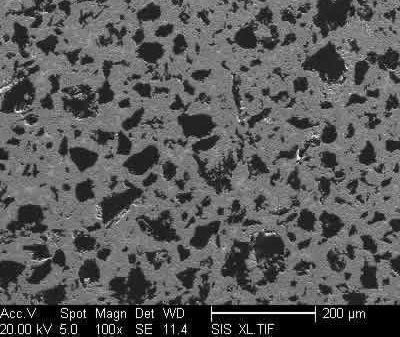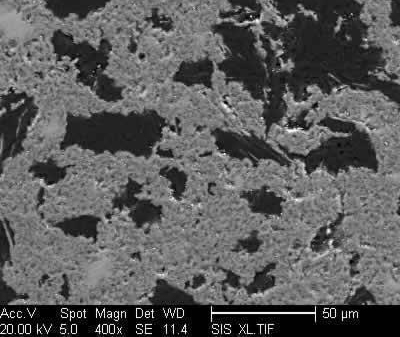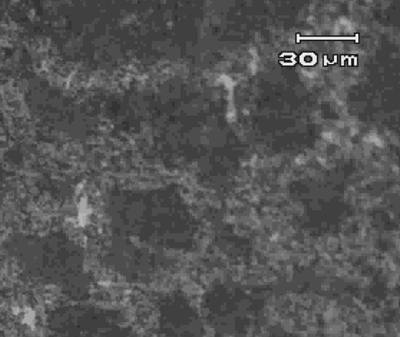|
Item
|
SiC30
|
GS-SIC
|
|
Production method
|
The initial state of matrix structure is composed of multihole particulate artificial graphite powder blanks. During sintering process, the mentioned graphite powder blanks will be put in molten free silicon for its penetration into the holes of graphite to react with graphite and generate silicon carbide. The sintering process will continue reaction until the holes are fully filled with silicon carbide and a small amount of free silicon. The sintering process is completed at a temperature of 1400 °C. |
The initial state of the matrix structure is composed of pressed multihole artificial graphite powder and free silicon powder. Then it is put in molten free silicon for its penetration into the holes of graphite under a gas pressure of 1-10MPa to react with graphite and generate silicon carbide. The sintering process will continue reaction until the holes are fully filled with generated silicon carbide. Then the mentioned workpieces will be sintered in vacuum sintering furnace so that free silicon and graphite powder will eventually completely react into silicon carbide. |
|
Structure
|
The microstructure is an interpenetrating network of graphite and silicon carbide. Some holes are filled with a small amount (approximately 4% Wt%) of free silicon, presenting bright white spots. Graphite phase presents dark spots. |
The microstructure is an interpenetrating network of graphite and silicon carbide without free silicon. The whole matrix structure presents a uniform color with some graphite phase presents dark spots, and the number relates to the lattice phase of graphite. |
|
Organic uniformity
|
Thick parts may easily lead to uneven immersed silicon, high free silicon content on surface while little in core, and no reaction between a large amount of graphite and free silicon reaction. Therefore a large number of pores emerge, forming the defects of lacking graphite content on surface, poor lubricating performance, and poor corrosion resistance. |
|
|
Ingredient
|
Mainly includes about 62% of silicon carbide, about 35% of graphite, and about 3% of free silicon. The volume is composed of 53% of silicon carbide, 43% of graphite, and about 4% of silicon. About 95% of silicon carbide is composed of cubic β-silicon carbide, and 5% is α-silicon carbide. |
Mainly includes about 70% of silicon carbide, about 30% of graphite, and no free silicon. About 95% of silicon carbide is composed of α-silicon carbide.
|
|
Chemical properties
|
Mainly silicon carbide and graphite. Containing 4% of free silicon. Silicon carbide and graphite are highly resistant to corrosive substances, and the overall corrosion resistance depends on the content of free silicon. Poor corrosion resistance of free silicon results in separation of matrix silicon carbide from graphite, leading to the material's decreasing strength in corrosive media and serious impact on service life. Not suitable for strong acid and alkali conditions. |
Mainly silicon carbide and graphite without free silicon. Silicon carbide and graphite are highly resistant to corrosive substances, and the overall corrosion resistance is good. Strength is not affected in corrosive media, and service life is long. |
|
Physical properties
|
The main physical data are listed in the performance table. |
The main physical data are listed in the performance table. |
|
Resistance to high temperature
|
As graphite is easily oxidized in oxidizing atmosphere, the use temperature cannot be higher than 650 °C. Neither graphite nor silicon carbide is oxidized in non-oxidizing atmosphere, but this contains free silicon whose melting point limits the maximum use temperature of not higher than 1350 °C. |
As graphite is easily oxidized in oxidizing atmosphere, the use temperature cannot be higher than 650 °C. In non-oxidizing atmosphere, because of no free silicon, the maximum use temperature can reach 1650 °C without reducing strength.。 |
|
Resistance to heat shock
|
|
|
|
Scope of application
|
Gas, liquid gasket rings and sliding bearings in conditions without lubrication or corrosive media. Up to 550 °C for long-term service in oxidizing atmosphere, and up to 1100°C for long-term service in non-oxidizing atmosphere. |
Particularly suitable for gasket rings in gas and liquid sealing elements in conditions of strong acid, alkali and other corrosive media with no lubrication, and sliding bearings for various noncorrosive pumps with possible dry friction. Available to assemble with graphite or pressureless sintered silicon carbide ceramic and can obtain better effect if assemble with itself. Up to 550 °C for long-term service in oxidizing atmosphere, and up to 1650°C for long-term service in non-oxidizing atmosphere. |




